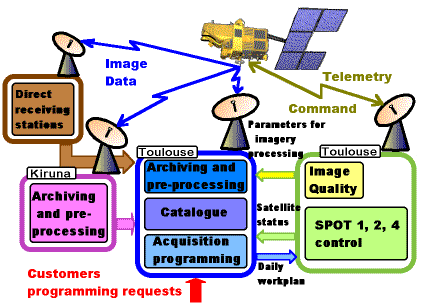
The SPOT system comprises several satellites together with efficient ground equipment and computer systems:
Programming
Centre
Control centres
Satellite monitoring stations
Direct Receiving Stations
Image transmission via
laser link
Image processing
Catalogue
The Programming Centre examines programming requests to select those likely to be acquired for customers on a given day. The Centre also determines whether a new programming request is feasible and then gives regular progress reports. This new Centre takes into consideration worldwide cloud cover forecasts issued daily by Météo-France, so as to take advantage of fine weather whenever possible (images are often rejected because of cloud cover). The Programming Centre is run by Spot Image.
Each control centre generates commands to send its satellite (SPOT 1, SPOT 2, …), information on scenes to be acquired on a given day. Specific commands can also be sent to adjust the position of an orbiting satellite or, in the event of failure, to switch from the nominal equipment to its backup. The control centres also analyse the telemetry downlinked to Earth several times a day to monitor satellite operation. These control centres, known as "operation control centres ", were developed by CNES on its Toulouse site (CST). The CST is also responsible for running the centres.
To exchange telemetry and commands between the satellites and control centres, the control centres rely on a set of stations scattered throughout the world; the two stations at Aussaguel (near Toulouse, France) and Kiruna (in northern Sweden) are used to send the commands to the satellites and receive telemetry. These stations operate in a radio band known as " S-band" (2 GHz). There is actually a network of stations (in South Africa, French Guiana and the Kerguelen islands, etc.) and relay systems which may be used to monitor not only SPOT satellites, but also other satellites using the same frequency band. This TT&C network, also known as the" 2 GHz network", was set up and is run by CNES from Toulouse. For special operations such as launches, CNES also relies on the stations of other space agencies (NASA in the United States, NASDA in Japan, the CCRS in Canada).
The two main stations at Aussaguel and Kiruna also receive imagery acquired by the SPOT satellites. In this case, they operate in a radio band known as " X-band " (8 GHz). There are over twenty direct receiving stations (or " "DRSs" ") operating in X band, which means that images can be acquired very rapidly. Their geographic distribution is such that SPOT satellites are nearly always within range of one or more DRSs. The organizations that run the direct receiving stations can book orbit slots with the Programming Centre to have exclusive use of a satellite for their own needs.
By the year 2000 it will be possible to relay image data over a laser link (using the Pastel terminal flown on SPOT 4) via the geostationary Artemis data relay satellite. This new system, Silex, represents a technological breakthrough as it will allow data to be transmitted at high speed between a SPOT satellite orbiting at an altitude of around 830 km and a second satellite remaining in the same position with respect to the Earth (geostationary) but at a distance of some 36,000 km. Development of the equipment for this experiment is being managed by the European Space Agency.
Once received by the ground segment, the image data are sent to the archive and preprocessing centre, again run by Spot Image. There is an identical image processing centre in Kiruna. The Kiruna station is so far north (nearly at the north pole) that SPOT satellites often pass within range. Both these centres are designed not only to archive the images acquired but also to process the raw data so that they may be used by system customers. Sophisticated image processing algorithms are used to guarantee the irreproachable quality of SPOT imagery. Some direct receiving stations are also able to archive and process the images that they receive directly.
It is very easy to consult the Dali catalogue of existing SPOT imagery . The catalogue enables customers to check whether scenes have already been taken of the region in which they are interested. Given the number of SPOT scenes already catalogued (over 5 million), it is likely they will find what they are looking for!
Should a search prove unsuccessful, Spot Image is there to draw up a new programming request for the SPOT satellites to meet customers' requirements.
![]()
page updated on the 00-06-06